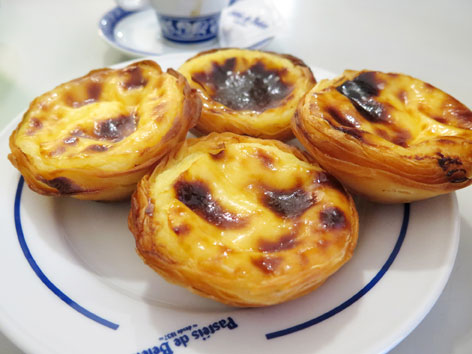
What: Aka pastéis de nata or pastéis de Belém, these flaky, sunny, slightly burnt-on-top egg custard tarts may be Portugal’s most famous export (after port wine, perhaps). You’ll find them in Portuguese bakeries and Chinatowns the world over (they’re similar to the egg tarts beloved by Macau and Hong Kong; see below), and pretty much anywhere there’s a sizable Portuguese community (say, in Montreal alongside Portuguese-style roast chicken). The origin of this rich, creamy treat is allegedly right here in Lisbon, in the southwestern Belém district, still the best place to gorge on these: According to , sometime after 1834, the year all monasteries and convents in Portugal were shut down as a result of the Liberal Revolution of 1820, someone from the Mosteiro dos Jerónimos (the Hieronymite Monastery) in Belém began selling these sweet pastries (fortunately there was a sugar cane refinery next door to the monastery); the year production in the current bakery officially began was 1837.
But they’re found in any pastelaria (bakery) in town, and even mediocre pasteles that have been sitting out a bit too long are pretty tasty. The really good ones, though? Downright divine. The traditional way to eat them is fresh out of the oven, dusted with cinnamon and sugar.
Good to know: The Portuguese are definitely behind the egg tarts of Macau, a former Portuguese colony (although, confusingly, the most popular variety there is actually a “Portuguese-English hybrid” tart created in 1989). Meanwhile, the Cantonese egg tarts are said to have origins in English custard tarts; Hong Kong, for one, was under British rule for a century and a half—but surely the pastel de nata played a role there too. They look similar, but an obvious distinction is that Portuguese tarts are larger and have a scorched, caramelized top, while the Chinese ones are unadorned and pale yellow.
Where: Since 1837, (Rue Belém 84-92, map) has churned these out, following the old secret recipe from the shuttered monastery next door. In fact the cream and pastry for the tarts are still created daily, by hand, in what’s called the “Secret Room.” Used to be that Belém was “far” from Lisbon, only accessible via steamboat. Now it’s just a quick tram ride away (No. 15 is an easy route), and there’s a steady stream of people coming daily from Lisbon and elsewhere to visit this cavernous, bustling bakery.
When: Daily, 8am-11pm (Oct. 1-June 30); 8am-midnight (July 1-Sept. 30)
Order: As many of those warm, fresh-baked, crispy-flaked ridiculously creamy pastéis de Belém as you can physically handle (€1.05 each). For real: This is a world heritage food, 100% worth the trip to Belém alone. There’s sugar and cinnamon on the table to use as you wish, but we didn’t think they needed a damn thing. The bakery also has a full roster of delicious-looking/sounding sweets—try what you like, but know that you are here for one thing, and one thing only. Plus some bicas (espressos) to drink alongside.
Good to know: While in Belém, don’t miss the incredible Museu Coleção Berardo (free on Saturdays) and, of course, the landmark Torre de Belém.
Alternatively: If you can’t make it to Belém, fear not: There’s another great option right in Lisbon, Manteigaria (Rua do Loreto 2, map), in Baixa-Chiado. It too is a factory of fresh-baked pastel de nata, a mesmerizing process you can watch behind the kitchen’s glass walls. It’s much smaller and more neighborhoody-feeling than the one in Belém, and while not exactly the same, the pasteles are incredibly delicious here too. Bonus: It’s open till midnight, and makes a perfect post-dinner stop if you’re eating in the area. Our recommendation? Visit them both. Any spot devoting this much time and care into producing one thing incredibly well is 100% worth your patronage.
There has never been a better time to plan your next trip and make your Dream vacation a reality . Whether you've been dreaming of relaxing on a sun-kissed beach, exploring ancient cities, or embarking on an epic adventure, now is the perfect moment to make it happen.













